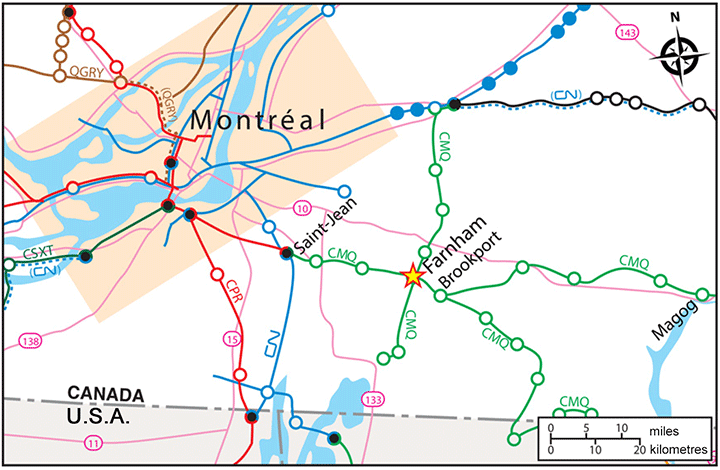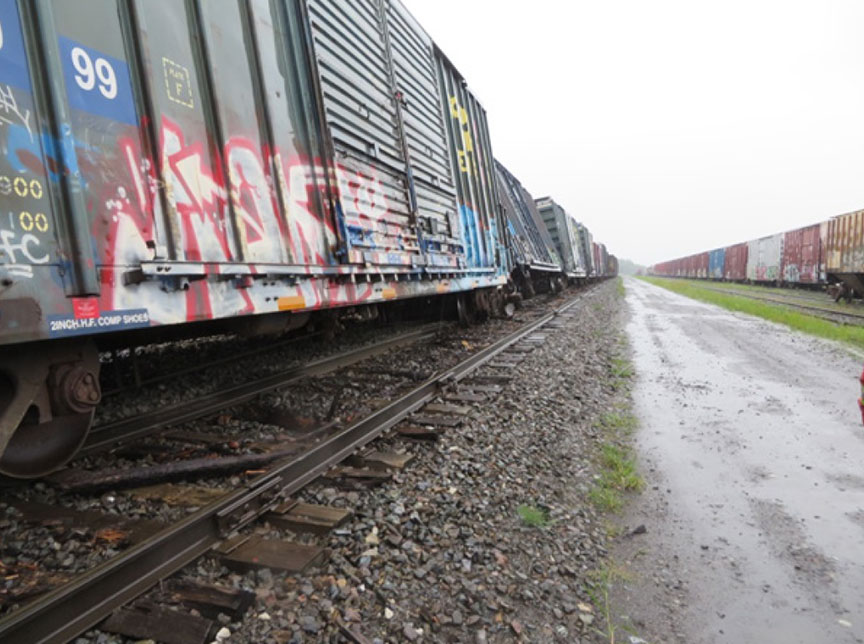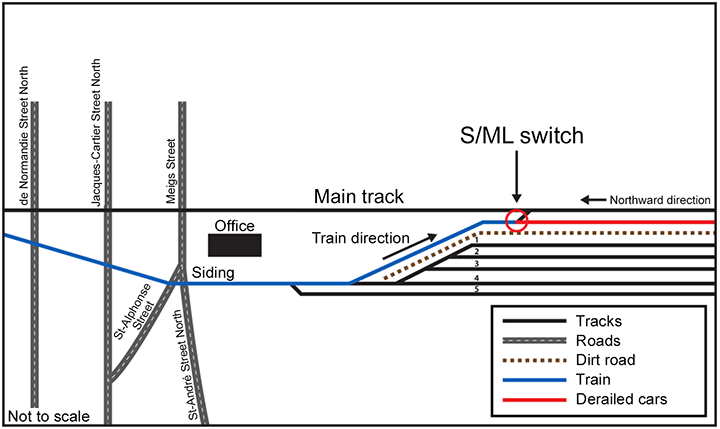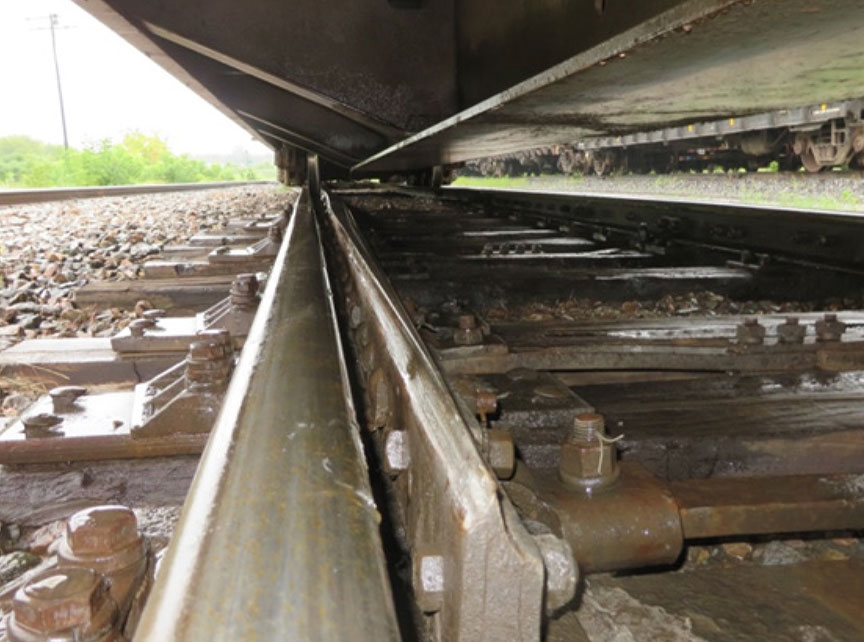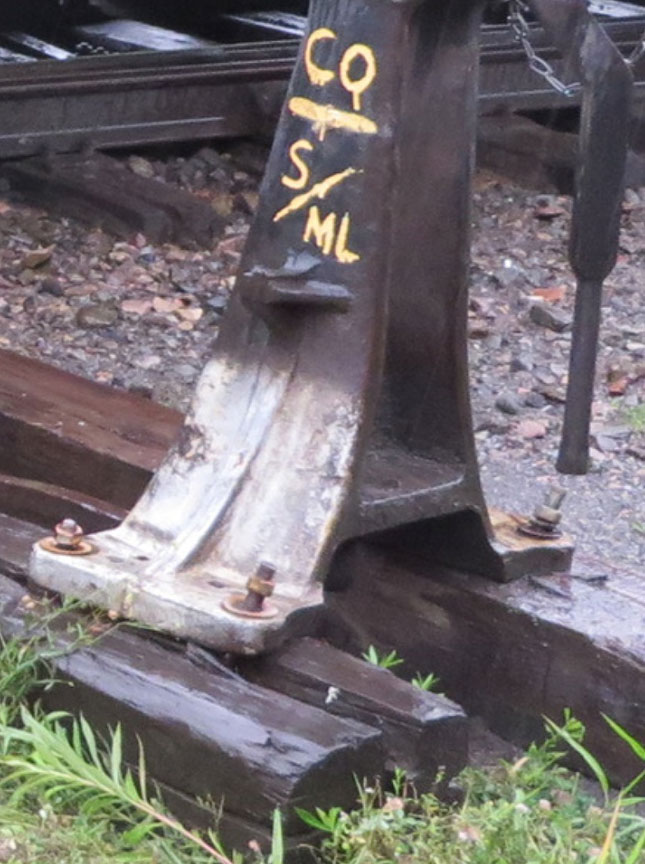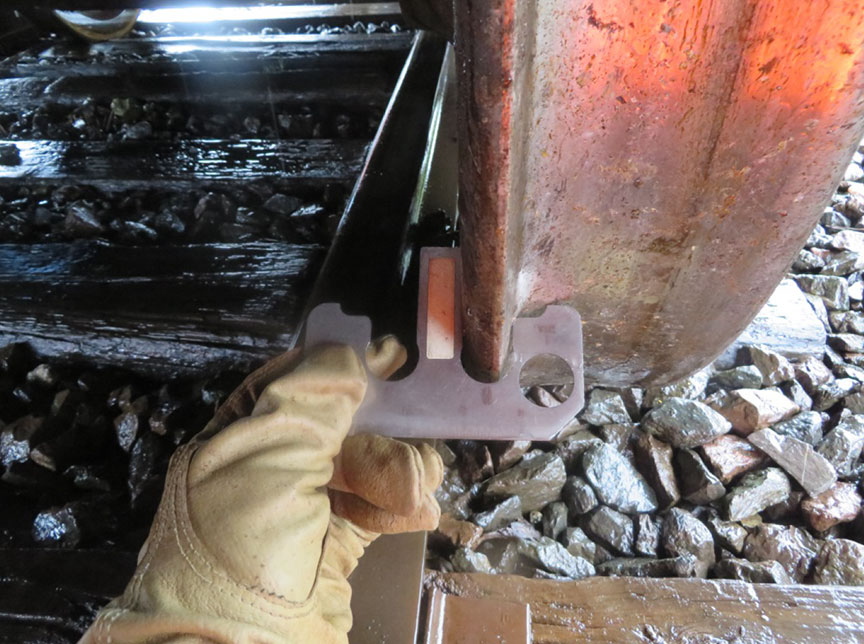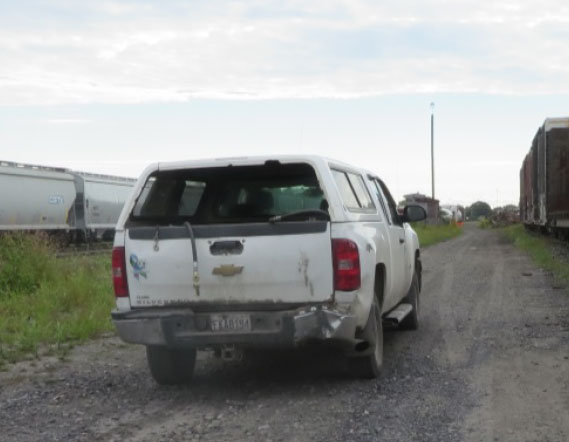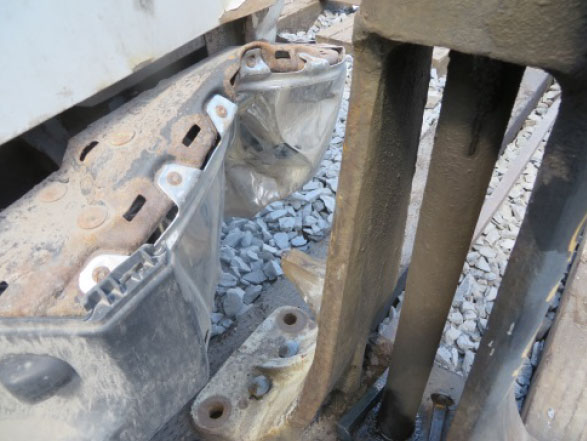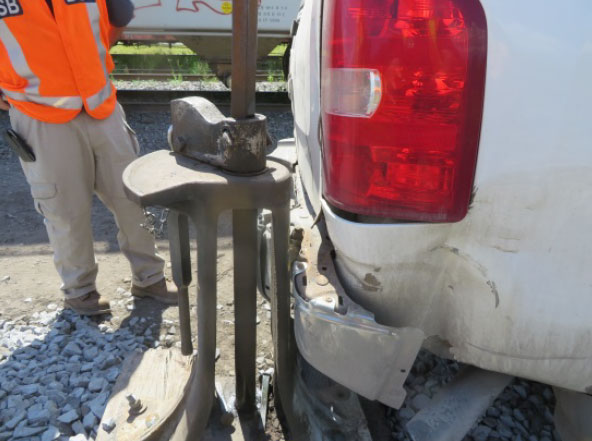Derailment
Central Maine & Québec Railway
Freight train 2-10
Mile 6.3, Adirondack Subdivision
Farnham, Quebec
The Transportation Safety Board of Canada (TSB) investigated this occurrence for the purpose of advancing transportation safety. It is not the function of the Board to assign fault or determine civil or criminal liability. This report is not created for use in the context of legal, disciplinary or other proceedings. See Ownership and use of content. Masculine pronouns and position titles may be used to signify all genders to comply with the Canadian Transportation Accident Investigation and Safety Board Act (S.C. 1989, c. 3).
Summary
On 10 August 2015, at about 2230 Eastern Daylight Time, while departing Farnham Yard, in Farnham, Quebec, 15 cars of Central Maine & Québec Railway freight train 2-10 derailed near the crossover between the siding and the main track of the Adirondack Subdivision. The crossover, a section of the siding of about 800 feet in length and the derailed cars were damaged. There were no injuries.
Le présent rapport est également disponible en français.
Factual information
The accident
On 10 August 2015, at about 1800,Footnote 1 a locomotive engineer (LE) and a conductor began their shifts at the Central Maine & Québec Railway (CMQ) Farnham Yard, in Farnham, Quebec. They were assigned to train 2-10 (the train), a freight train departing from Farnham Yard (Figure 1). Both crew members were familiar with the territory and met rest and fitness requirements.
Due to the length of the tracks in Farnham, the cars were marshalled on 3 separate tracks. Prior to departure, the train was assembled by coupling the 3 blocks, resulting in a train comprising 4 locomotives, 10 loaded cars and 91 empty cars. The train weighed about 5300 tonnes and was approximately 6800 feet long. The train was then left north of Farnham Yard, in the siding, for a certified car inspector to verify the application and release of the brakes on each car.
At about 2230, as it was leaving Farnham Yard, the train reached a speed of about 10 mph when it began to slow down. The LE tried to compensate by gradually moving the throttle to position 7, but the train continued to slow until a train-initiated emergency brake application brought it to a stop. Upon inspection, the train crew found that 15 cars, positions 8 to 22, had derailed (Photo 1).
Site examination
Farnham Yard is located in the centre of the town of Farnham. The Farnham Yard siding is located on the west side of the Adirondack Subdivision main track. A gravel road between the siding and the first yard track (track number 1) makes it possible to drive from one end of the yard to the other. Opposite the north end of track 1 is a hand-operated crossoverFootnote 2 linking the siding to the main track. A train travelling southward on the siding makes a “facing point” movementFootnote 3 (Figure 2).
As a result of the derailment, 4 public crossings were blocked by the train cars. To clear them, the tail end of the train had to be moved northward. The crossings were cleared at about 0500 the next morning when equipment accessed the tail end of the train and pulled it.
The siding was damaged for about 800 feet, starting at the switch points of the siding crossover switch (S/ML). The rail was ripped from its tie plates over a length of 300 feet, several ties were broken, and the ballast was displaced. Moreover, in the vicinity of the S/ML turnout, several main-track ties were struck, and both tracks were displaced.
The left switch point (east) of the S/ML turnout was about 2 inches from its stock rail (Photo 2). That switch point did not show any sign of impact or wear or any abnormal markings. The right switch point (west) of the turnout was 3 inches from its stock rail. It was chipped over a length of about 14 inches. Between the bent stock rail and the siding's rail, there were impact marks on the switch stop lugs, frog, tie plates, spikes and several ties. No switch rods were damaged.
The S/ML turnout was locked in normal position. One of the long ties under the switch stand was split. Three of the four bolts securing the switch stand to the long ties were bent southward (Photo 3), and the switch stand was loose. The ballast surrounding these ties was displaced southward.
All the derailed cars remained upright. However, some were leaning toward the main track, their trucks displaced from their supports. The 8th car in the consist (WCTR 866845) was the first derailed car. Its leading truck was on the rails while the trailing truck (A-end) had derailed.
Grooves were visible on the ties from the S/ML turnout to car WCTR 866845. Examination of the car wheels revealed that the R3 wheel flange exhibited wear that was near the 2014 Field Manual of the AAR Interchange Rules allowable limits (15∕16 inch) (Photo 4)
Track information
The Adirondack Subdivision extends from Brookport near Brigham, Quebec, Mile 0.0, to the Outremont Station, in Outremont, Quebec, Mile 49.1. CMQ is the owner of the portion of the subdivision between Mile 0 and Mile 20.
Between Mile 0 and Mile 20, the Adirondack Subdivision is a Class 2 single main trackFootnote 4 according to the Track Safety Rules (TSR) approved by Transport Canada (TC). Train movements are governed by the occupancy control system (OCS)Footnote 5, as authorized by the Canadian Rail Operating Rules (CROR), and supervised by a rail traffic controller (RTC). In addition to road switcher movements, 1 train travelled over the subdivision every 2nd day.
At Farnham Yard, the crossover connecting the siding to the main track is located near Mile 6, on a section of tangent track. Just prior the S/ML turnout, southward movements must negotiate a right-hand curve. The siding consisted of 100-pound rail laid on 10-inch single-shouldered tie plates secured with 2 spikes per tie. Every third tie was box-anchored, and the ballast consisted of ½- to 2-inch crushed rock.
S/ML turnout
The S/ML turnout is inspected on foot once a month, in accordance with the TSR. During that inspection, the employee must verify the condition of several components and record the results on an inspection form. That turnout was last inspected on 06 July 2015. During that inspection, 3 items requiring remedial action were noted:
- Pins were missing.
- The right switch point required replacement.
- The left switch stand tie was defective.
The S/ML switch had to be locked and left in normal position (i.e., lined up for the siding). In that position, the left switch point is pressed against the bent stock rail while the right switch point is about 5 inches from the right rail.
Car WCTR 866845
Car WCTR 866845 is a bulkhead flat car built in 1980. A detailed examination of the derailed car revealed the following anomalies:
- The 4 friction wedges of the A-end truck (derailed truck) were high (between ¾ inch and 1 5∕16 inches). These measurements exceeded the 2014 Field Manual of the AAR Interchange Rules allowable limits (¾ inch or more).
- Wear of the 4 constant contact side bearings (CCSB) of the car exceeded the 2014 Field Manual of the AAR Interchange Rules allowable limits.
According to the car's maintenance history, its last detailed inspection was performed in May 2014. During that inspection, neither the CCSBs nor the friction wedges were found to require remedial action. Moreover, the car's pre-departure inspection did not reveal any anomaly as CCSB and friction wedge wear is difficult to detect visually, particularly at night.
Inspections at Farnham Yard
At about 1400, a certified car inspector (the inspector) began his shift at the Farnham Yard. His first task was to inspect the cars that would form the train. The cars to be inspected were on tracks 1, 3 and 4. Using a pickup truck, the inspector drove to track 1 to begin the inspection. Once the inspection of the cars on that track was completed, he drove to the north end of the yard to inspect the cars on tracks 3 and 4. During that inspection, the inspector was called upon to complete other tasks and used the pickup truck to drive from one point to the next.
Pickup truck
Following the derailment, an examination of the pickup truck revealed damage to the rear bumper. That damage was not present when the inspector began his shift.
During a re-enactment, the damage to the bumper of the pickup truck was compared to the switch stand of the S/ML turnout. The shape of the damage to the bumper was consistent with the shape of the switch stand (Photo 5, Photo 6, and Photo 7).
Lead locomotive event recorder
Examination of the lead locomotive (CITX 3091) event recorder revealed that, in the moments before the train stopped (about 3 seconds):
- The load of the locomotive traction motor decreased quickly.
- Brake pipe pressure fell from 89 psi to 0.
- The pressure in the locomotive brake cylinder had started to increase.
- The locomotive throttle was reduced to the idle position.
- The power cut-off switch remained closed.
The locomotive event recorder (LER) data indicated that the power cut-off switch remained closed whereas, normally, it should open when the emergency brakes are applied. Consequently, tests were conducted on locomotive CITX 3091 to determine the cause of that anomaly. Testing showed that, each time the emergency brakes were applied, the power cut-off switch tripped open (as expected), whereas the LER showed that the power cut-off switch remained closed (did not trip). Testing also showed that some connectors were not positioned properly.
Analysis
No track defect was considered a factor in the accident. Examination of the locomotive event recorder (LER) data did not reveal any condition in the train handling that could have caused the derailment. The analysis will therefore focus on the siding crossover switch (S/ML), on car WCTR 866845, and on the power cut-off switch.
The accident
The marks on the tie plates, spikes and switch stop lugs were consistent with damage caused by the passage of several wheel flanges. The lack of damage north of the switch, the grooves leading from the S/ML turnout to car WCTR 866845, and the anomalies found on that car indicate that this car was the first to derail and that it derailed while it passed on the S/ML turnout, which was out of adjustment.
Since the constant contact side bearings (CCSB) and friction wedges of the trailing truck of car WCTR 866845 were worn beyond the allowable limits, the car's ability to negotiate curves was compromised. After exiting the curve immediately preceding the turnout, the trailing truck was no longer symmetric, forcing the flange of the lead wheel (R3 wheel) against the inside of the east rail. As a result, the flange of the R3 wheel became lodged between the left switch point and the bent stock rail, increasing the gap between the switch point and the bent stock rail, causing the derailment of that car and the next 14 cars.
An opening between the switch point and its stock rail indicates that the switch is either damaged or improperly adjusted. The fact that the switch points and the rods were not damaged excludes the possibility that the switch was run through by rolling stock. The long ties supporting the switch stand of the S/ML turnout were displaced southward, and the bolts used to secure the switch stand to the ties were bent in the same direction. In addition, there were rub marks on the north side of the switch stand. That damage indicates an impact of sufficient force to misalign the switch points and create an opening between the left switch point and the bent stock rail occurred. Since the damage to the bumper of the pickup truck was consistent with that observed on the switch stand, the misalignment of the switch points was caused by the pickup truck's impact.
Despite the extent of the damage sustained by the switch stand and the pickup truck, the damage was not reported and, consequently, its impact on the safe movement of rolling stock was not assessed. If switch-related incidents are not reported, damaged switches could remain in service, increasing the risk of derailment.
Power cut-off switch
Testing of the LER showed that the decrease in the load of the traction motor, the drop in brake pipe pressure, and the reduction of the locomotive throttle to the idle position could be accounted for by emergency braking. However, it was found that, each time the emergency brakes were applied, the locomotive power cut-off switch tripped open (as expected) whereas according to the LER, the power cut-off switch remained closed (did not trip). Since that anomaly is associated with improperly positioned connectors, all indications are that this situation is unique to this locomotive. As LER data are used to re-enact accidents, their accuracy is vital to properly conduct an investigation. When an LER does not accurately record the required parameters of a train's operation, the accuracy and validity of any analysis conducted using that incorrect information can be compromised.
Findings
Findings as to causes and contributing factors
- The train derailed while it passed on the siding crossover switch, which was out of adjustment.
- The flange of the R3 wheel of car WCTR 866845 became lodged between the left switch point and the bent stock rail, causing the derailment of that car and the next 14 cars.
- The misalignment of the switch points was caused by the pickup truck's impact with the switch stand.
Findings as to risk
- If switch-related incidents are not reported, damaged switches could remain in service, increasing the risk of derailment.
Other findings
- When a locomotive event recorder does not accurately record the required parameters of a train's operation, the accuracy and validity of any analysis conducted using that incorrect information can be compromised.
Safety action
Safety action taken
Rail safety information letter
On 12 November 2015, the Transportation Safety Board of Canada (TSB) issued Rail Safety Information Letter 14/15 to Transport Canada (TC) regarding the incorrect data recorded by the locomotive event recorder (LER). In that letter, the TSB stated that the position of the power cut-off switch as recorded by the LER (i.e., did not trip) was inconsistent with emergency braking. When the emergency brakes are applied, the power cut-off switch opens to stop the flow of electrical current generated by the locomotive's main alternator to the traction motors. After testing, the TSB confirmed that the LER did not correctly record the position of the power cut-off switch.
Since LER data are used to re-enact accidents, their accuracy is vital for the proper conduct of an investigation. When an LER does not accurately record the required parameters of a train's operation, the accuracy and validity of any analysis conducted using that incorrect information can be compromised.
On 09 February 2016, TC replied that railway companies are responsible to carry out yearly inspections and accuracy testing of the LER and the event recorder's memory module. In addition, on 26 January 2016, TC's Quebec regional office tested data extracted from the LER of locomotive CITX 3091; the LER had recorded that the power cut-off was open during the emergency brake application.
This report concludes the Transportation Safety Board's investigation into this occurrence. the Board authorized the release of this report on . It was officially released on 13 June 2016.
